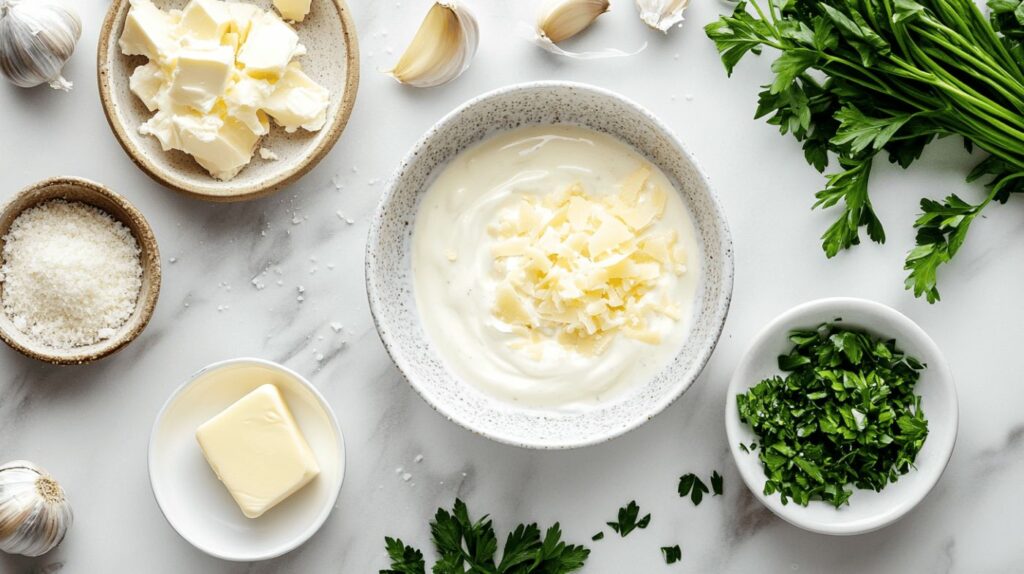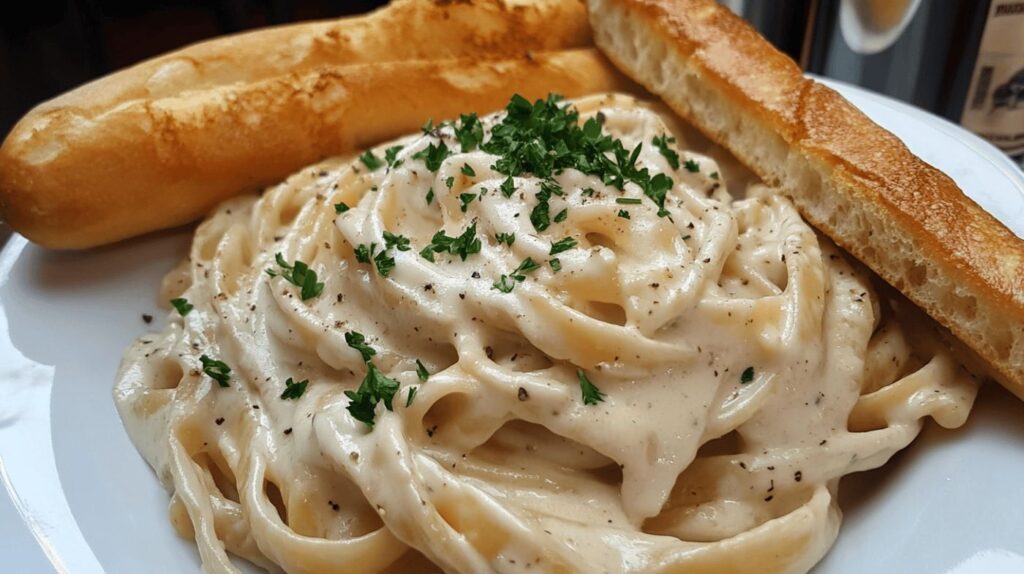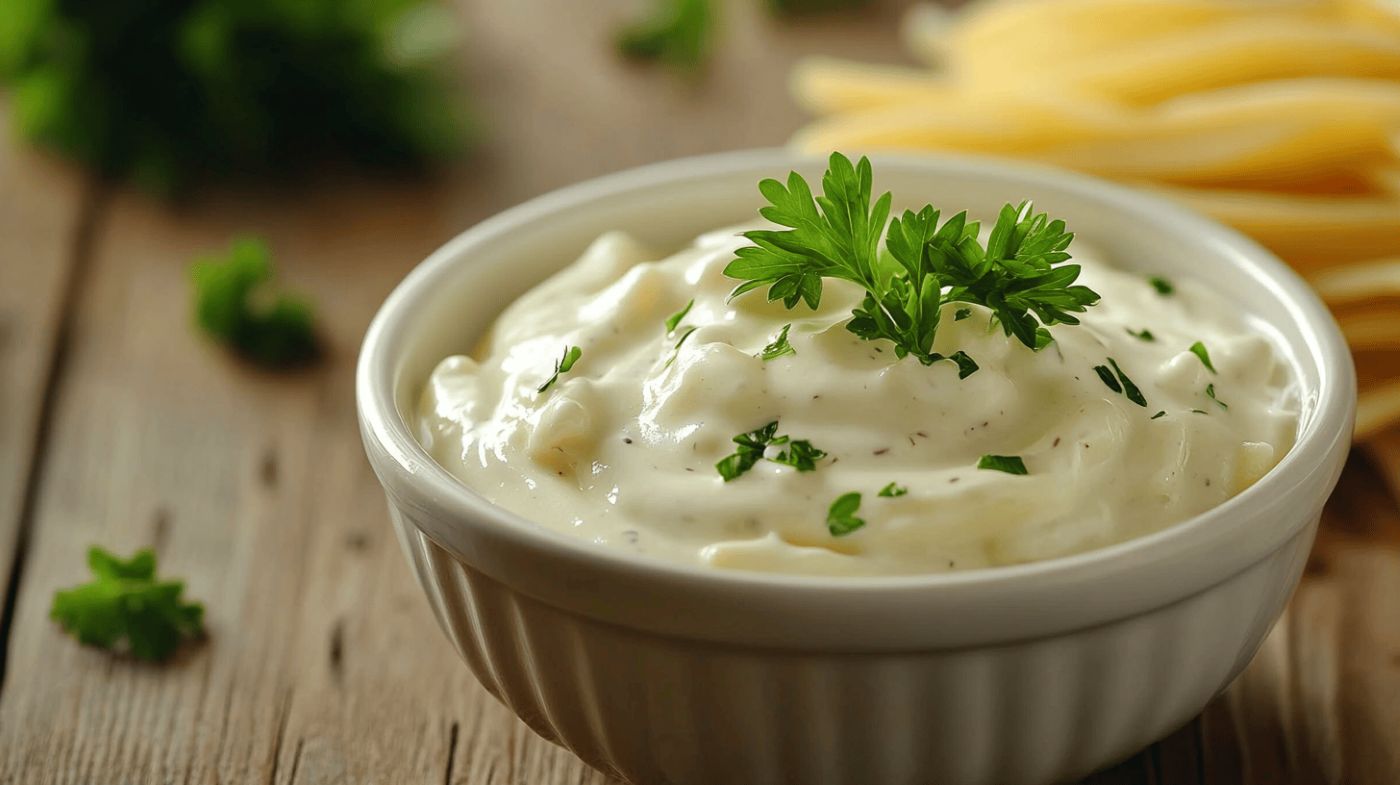Table of Contents
Introduction to Olive Garden’s Alfredo Sauce
Why Is Olive Garden’s Alfredo Sauce So Popular?
Olive Garden’s Alfredo sauce has become a household name for its creamy, rich texture and perfectly balanced flavor. Its popularity stems from its ability to elevate any pasta dish into a comforting, indulgent meal. The sauce’s velvety smoothness and savory undertones make it irresistible to both seasoned foodies and casual diners alike. Unlike many store-bought options, Olive Garden’s version offers a fresh, restaurant-quality taste that feels luxurious but approachable.
Key Ingredients That Make It Unique
The magic of this Alfredo sauce lies in its carefully chosen ingredients. Fresh heavy cream provides the silky base, while real butter adds richness. Aged Parmesan and Romano cheeses bring depth and a slightly nutty flavor, which is enhanced by a touch of garlic. The balance of these elements creates a sauce that’s creamy without being heavy and flavorful without being overpowering.
Ingredients You’ll Need

A Detailed Look at Each Ingredient
- Heavy Cream: This is the foundation of the sauce, giving it its creamy texture. Ensure you use fresh, full-fat cream for the best results.
- Butter: Adds a luxurious richness to the sauce. Unsalted butter is ideal to better control the salt level.
- Parmesan Cheese: Provides the primary cheesy flavor. Use freshly grated Parmesan for a smoother consistency and better taste.
- Romano Cheese: Complements Parmesan with a tangier, sharper note. A small amount goes a long way.
- Garlic: Freshly minced garlic infuses the sauce with aromatic depth.
- Salt and Pepper: Simple seasonings that enhance all the other flavors.
- Nutmeg (Optional): Adds a subtle warmth that rounds out the sauce without overpowering it.
Optional Additions for a Twist on the Classic Recipe
You can customize this sauce by adding fresh herbs like parsley or basil for a touch of freshness. Crumbled bacon or sautéed mushrooms also add interesting textures and flavors. For a spicy kick, a dash of red pepper flakes works wonders.
Equipment Checklist
Essential Tools for the Perfect Alfredo Sauce
- Saucepan: A heavy-bottomed pan ensures even cooking and prevents scorching.
- Whisk: Essential for blending the ingredients and achieving a smooth texture.
- Ladle: Useful for portioning and serving the sauce.
- Measuring Cups and Spoons: To ensure precise ingredient quantities.
Tips for Choosing the Right Cooking Utensils
Choose non-stick or stainless steel pans for easy cleanup. Opt for silicone or wooden utensils to avoid scratching cookware surfaces. A fine grater is crucial for achieving smooth, melt-in-your-mouth cheese shavings.
Step-by-Step Recipe for Olive Garden Alfredo Sauce
Preparing the Ingredients
Preparation is key to ensuring the sauce comes together seamlessly. Follow these detailed steps to set up your ingredients:
- Measure the Ingredients: Accurately measure 1 cup of heavy cream, ½ cup of grated Parmesan cheese, ¼ cup of grated Romano cheese, and ½ stick (4 tablespoons) of unsalted butter. This ensures a consistent flavor and texture.
- Grate the Cheeses: For the smoothest sauce, grate Parmesan and Romano cheeses finely. Pre-grated options often contain anti-caking agents that can affect the sauce’s texture, so fresh is always better.
- Mince the Garlic: Use 2–3 fresh garlic cloves, depending on your taste preferences. Mince them finely to ensure they evenly distribute throughout the sauce without creating overpowering bites.
- Prepare Optional Additions: If you’re planning to add extra flavor, such as fresh herbs (parsley, basil) or red pepper flakes, have them chopped and ready.
- Set Out Tools: Ensure all your equipment—saucepan, whisk, and measuring tools—are clean and within reach for a smooth cooking process.
Cooking the Sauce: A Detailed Process
Creating the perfect Alfredo sauce involves precise steps to achieve the creamy, rich texture Olive Garden is known for. Here’s how to do it:
- Melt the Butter:
- Place a heavy-bottomed saucepan over medium-low heat. Add the butter and let it melt gently, stirring occasionally to prevent browning.
- Avoid high heat at this stage, as browned butter changes the sauce’s flavor profile.
- Sauté the Garlic:
- Once the butter has melted, add the minced garlic to the pan. Stir it constantly for about 30–60 seconds, just until it becomes fragrant. Be careful not to burn the garlic, as this can introduce bitterness.
- Incorporate the Heavy Cream:
- Gradually pour in the heavy cream while whisking continuously to combine it with the butter. This step ensures a smooth, creamy base for the sauce.
- Continue stirring and let the mixture warm over medium-low heat. Avoid letting it boil, as this can cause separation.
- Add the Cheese:
- Reduce the heat to low. Begin adding the grated Parmesan cheese in small handfuls, whisking thoroughly after each addition. Allow each batch to melt completely before adding more.
- Repeat the process with the Romano cheese, ensuring it fully integrates with the sauce. This step is critical for achieving a silky texture.
- Season the Sauce:
- Add a pinch of salt, freshly cracked black pepper, and a tiny pinch of nutmeg (optional) to enhance the flavors. Taste the sauce and adjust the seasoning as needed.
- Simmer to Thicken:
- Allow the sauce to simmer gently for 3–5 minutes, stirring frequently. This step thickens the sauce slightly and allows the flavors to meld.
- If the sauce thickens too much, add a splash of milk or reserved pasta water to reach your desired consistency.
Tips for Achieving the Perfect Consistency
- Whisk Constantly: Continuous whisking prevents lumps and ensures all ingredients blend smoothly.
- Control the Heat: Always use medium or low heat. High heat can cause the cheese to clump or the cream to separate.
- Timing with Cheese: Adding cheese too early or too quickly can result in a gritty sauce. Gradual incorporation over low heat is key.
- Pasta Water Trick: If serving the sauce with pasta, reserve a small amount of pasta cooking water. Adding a tablespoon or two to the sauce before serving can enhance its texture and help it cling better to the pasta.
This method ensures a smooth, rich Alfredo sauce with the perfect balance of creaminess and flavor, just like Olive Garden’s famous recipe.
Common Mistakes and How to Avoid Them
Overheating the Sauce
High heat can cause the cream to curdle or the cheese to separate. Always use medium to low heat and keep an eye on the saucepan.
Fixing Lumpy or Grainy Alfredo Sauce
Lumpy sauce often results from adding cheese too quickly. Incorporate cheese gradually and ensure it melts fully before adding more. Whisking continuously also helps maintain smoothness.
Balancing the Flavors Perfectly
If the sauce tastes too salty, add a splash of cream to balance it out. For bland sauce, adjust with a bit more cheese or a touch of garlic.
Nutritional Information
Calories and Macronutrients
A typical serving of Alfredo sauce contains about 400–500 calories, with a balance of fats, protein, and carbohydrates. The high-fat content comes primarily from the butter and cream, while the cheeses provide protein.
How to Make a Healthier Alfredo Sauce
For a lighter version, substitute heavy cream with half-and-half or whole milk. Use less butter and choose low-fat cheeses. Adding a touch of Greek yogurt can also maintain creaminess while reducing calories.
Serving Suggestions

Classic Pairings for Alfredo Sauce
Fettuccine is the traditional choice for Alfredo sauce, as its flat, wide shape holds the sauce beautifully. Other great options include penne, spaghetti, or linguine.
Creative Serving Ideas
Try using Alfredo sauce as a topping for baked potatoes or as a dipping sauce for breadsticks. It also pairs well with grilled chicken, shrimp, or steamed vegetables like broccoli and asparagus.
Storing and Reheating Tips
Proper Storage Techniques
Properly storing your Alfredo sauce ensures it retains its creamy texture and rich flavor when reheated. Here’s how to do it right:
- Cool the Sauce Completely:
- Allow the Alfredo sauce to cool to room temperature before storing it. Storing hot sauce can create condensation, which may lead to excess moisture and an altered texture.
- Use an Airtight Container:
- Transfer the cooled sauce into an airtight container. Glass or BPA-free plastic containers with secure lids are ideal to prevent air exposure and keep the sauce fresh.
- Layer Plastic Wrap (Optional):
- For extra protection, press a layer of plastic wrap directly onto the surface of the sauce before sealing the container. This prevents a skin from forming on top of the sauce.
- Refrigerate Immediately:
- Place the container in the refrigerator within two hours of cooking. Alfredo sauce can be stored in the fridge for up to 3 days. Beyond this, its texture and flavor may start to degrade.
- Label and Date:
- If you’re storing multiple leftovers, label the container with the date. This helps track its freshness and avoid accidental waste.
- Freezing for Long-Term Storage:
- Alfredo sauce can be frozen, though the texture may change slightly due to the cream. To freeze, pour the cooled sauce into a freezer-safe container, leaving about an inch of space at the top for expansion. It can be stored in the freezer for up to 2 months.
Reheating Without Losing Flavor
Reheating Alfredo sauce requires gentle care to maintain its creamy consistency and prevent separation. Follow these steps for the best results:
- Thaw (If Frozen):
- If the sauce is frozen, transfer it to the refrigerator and allow it to thaw overnight. Avoid microwaving frozen sauce directly, as this can cause uneven reheating.
- Use Low Heat:
- Place the sauce in a saucepan over low heat. Avoid high heat, which can cause the cream to curdle or the cheese to separate. Stir constantly as the sauce warms.
- Add Liquid to Restore Texture:
- Alfredo sauce tends to thicken after refrigeration. To restore its original consistency, add a splash of milk, cream, or reserved pasta water while reheating. Add the liquid gradually, stirring until you reach the desired thickness.
- Microwave Method:
- If you’re short on time, you can reheat Alfredo sauce in the microwave. Use a microwave-safe bowl, cover it loosely with a lid or damp paper towel, and heat in 15–20 second intervals. Stir between each interval to ensure even heating.
- Avoid Overheating:
- Overheating Alfredo sauce can cause the fats to separate, resulting in a greasy texture. Reheat just until warm, not boiling.
- Enhance Flavor (Optional):
- Reheated sauce may lose some of its original flavor. To brighten it up, add a small pinch of salt, pepper, or freshly grated Parmesan before serving.
- Pair with Fresh Pasta or Ingredients:
- When reheating sauce, pairing it with freshly cooked pasta or vegetables can help rejuvenate its flavor and texture. Toss the sauce with warm pasta directly in the saucepan to combine.
Quick Tips for Best Results
- Don’t Reheat Multiple Times: Only reheat the portion you plan to use. Repeated reheating can degrade the quality of the sauce.
- Avoid Using a Metal Container for Storage: Acidic components like cheese can react with certain metals, affecting the taste. Stick to glass or food-grade plastic.
- Freeze in Small Portions: If freezing, divide the sauce into smaller portions for easy reheating without wasting leftovers.
By following these techniques, you can store and reheat your homemade Alfredo sauce while preserving its creamy, delicious quality.
Variations of Alfredo Sauce
Vegan Alfredo Sauce
Replace butter with plant-based alternatives and use cashew cream instead of heavy cream. Nutritional yeast can mimic the cheesy flavor, while garlic and nutmeg maintain depth.
Gluten-Free Alfredo Sauce
Ensure all ingredients, especially cheeses and seasonings, are certified gluten-free. Use cornstarch or gluten-free flour to adjust the consistency if needed.
Spicy Alfredo Sauce
Add red pepper flakes or a splash of hot sauce for a spicy twist. Jalapeño-infused oil can also bring a unique kick.
Troubleshooting Your Alfredo Sauce
What to Do If the Sauce Splits
Remove the pan from heat immediately and whisk in a splash of cold cream to bring the sauce back together. A bit of butter can also help restore its smooth texture.
Adjusting the Thickness After Cooking
If the sauce is too thick, stir in a small amount of milk or cream. For a thicker sauce, let it simmer longer or mix in additional grated cheese.
FAQs About Olive Garden Alfredo Sauce
What is Olive Garden’s Alfredo Sauce Made Of?
Olive Garden’s Alfredo sauce is crafted from a few simple yet flavorful ingredients. The core components include heavy cream, unsalted butter, Parmesan cheese, garlic, and a touch of salt and pepper for seasoning. These ingredients are combined to create the rich, velvety texture and bold, savory flavor that make the sauce so iconic.
Why Does Olive Garden Alfredo Taste Different?
The distinct taste of Olive Garden’s Alfredo sauce comes down to its recipe and preparation. They use high-quality ingredients, such as freshly grated Parmesan and real cream, ensuring a rich and authentic flavor. Additionally, Olive Garden may include proprietary seasoning blends or techniques that add a unique depth. When making it at home, the key is to focus on freshness and balance for a comparable flavor.
Does Costco Sell Rao’s Alfredo Sauce?
Yes, Costco often carries Rao’s Alfredo sauce in select locations. Rao’s is known for its premium-quality sauces, including Alfredo, which is a favorite for its creamy texture and natural ingredients. While it’s not the same as Olive Garden’s Alfredo sauce, Rao’s version is highly regarded and can be a convenient option for those seeking a store-bought alternative.
What is the White Dipping Sauce at Olive Garden?
The white dipping sauce at Olive Garden is often their Alfredo sauce, served as a side for dipping breadsticks, fried appetizers, or other items. This creamy sauce adds a luxurious touch to any dish, making it a versatile and popular choice for enhancing the restaurant’s menu items. You can recreate this dipping sauce at home using Olive Garden’s Alfredo recipe or any quality Alfredo sauce.
Based on the sitemap of Cooking Flare, here are some relevant internal linking suggestions:
- Use the article “Perfect Cracker Barrel Meatloaf Recipe: A Complete Guide” to highlight comfort food pairings.
- Link to “What Is the Secret to Juicy Meatloaf? Discover the Ultimate Tips” to discuss the importance of moisture in classic recipes.
- Refer to “What Makes Texas Chili Different? Discover the Unique Flavors of Texas” when exploring regional flavor contrasts.
Conclusion
Why You Should Try This Recipe Today
Making Olive Garden-style Alfredo sauce at home is a simple yet rewarding experience. The rich, creamy flavor rivals restaurant quality and can be tailored to your taste preferences. Plus, it’s a crowd-pleaser that’s perfect for any occasion.
Share Your Experience with Homemade Alfredo Sauce
Once you’ve tried this recipe, share your results with friends and family. Your take on this classic sauce might inspire others to explore the joys of homemade cooking.

